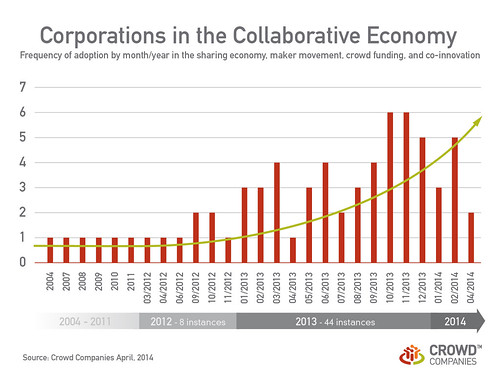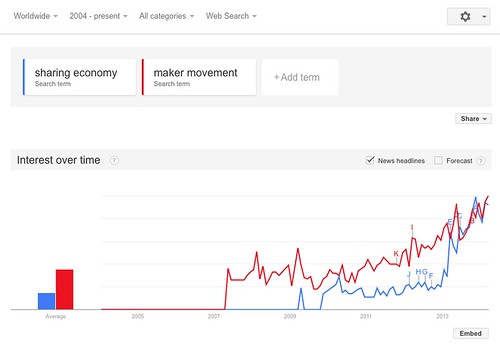140 character summary: Brands joining the collaborative economy at a rapid pace as a P2P economy rises. http://tinyurl.com/kuw3wzl

The above frequency chart (up till April 2nd, 2014) shows the instances of corporations who’ve deployed in the Collaborative Economy, based on this growing list.
The Collaborative Economy Empowers Peer 2 Peer Commerce.
I’ve written a fair amount about corporations in the Collaborative Economy, and have even started an association for large companies, called Crowd Companies. , so tracking this space is not just a passion, but core to my work. In a future post, I’ll list out the specific instances in a timeline, so you can further see how companies are moving into this space.
- This movement shifts power to the people but brands aren’t idly standing by. The Collaborative Economy is a powerful movement. The people can get what they need from each other through peer funding, making, 3D printing and by sharing goods, instead of buying them. This movement is disruptive. Some taxi companies’ revenues have dropped by as much as 40% where they are being displaced by the popularity of ride-sharing startups. Airbnb is now worth more than some traditional hotel chains. Airbnb is usurping the market dominance of hotels. Uber and Lyft are changing the paradigm of owning cars to sharing cars. Crowd funding shifts power away from banks. oDesk shifts power away from traditional consulting and Etsy shifts away from traditional retailers.
- Although much is still experimental, there was an increase in brands embracing the sharing economy in 2013. Just as they did with social media, companies will join, influence, and eventually participate in this movement. In 2012 there were a mere eight instances of corporations in the space, including Patagonia, partnering with eBay for used good resale, West Elm reselling maker goods from the Etsy community at retailers, and UK retailer B&Q launching a community to encourage sharing of goods at the local neighborhood level. In 2013 we saw much more adoption, with 44 instances of corporations moving forward with experiments, partnerships, sponsorships and more.
- Forecast: 2014 promises increased growth as the movement prospers. This P2P movement is growing. The graph below shows the Google Insights trends of people searching for this market, with a strong uptick to the right. Don’t expect corporations or their agencies and consulting partners to stand idly by. They’ll use the same tools and strategies this coming year and beyond. 2013 showed a 550% growth rate in some instances. If that rate continues, we could expect a whopping 242 new instances of corporate movement into this space in 2014. If current patterns repeat, we should see a bolstering in this space in the last quarter of 2014.

Above: Google Insights, which tracks how people are searching for terms, indicates a rapid rise in people searching for the terms sharing economy and maker movement, the two key trends in the collaborative economy movement which will trigger brands to follow the action. See the live graph.
Summary: Companies will increase partnerships with the empowered crowd
The first phase of sharing was social media. People created media and shared it, bypassing corporate-created content. In the second phase, the Collaborative Economy, people are creating products and sharing them without having to buy from companies. Read the full report on their behavior change. Companies must adjust their business model to partner with the empowered crowd.
Thank you, Vlad and Julie G., for your help in production and research. Thanks to Lisa Gansky, Fred Neil, Alexandra Samuel, Terry Young, Angus Nelson, and Vivian Wang for your insights.
6 Replies to “Brands On the Rise In the Collaborative Economy”
Comments are closed.